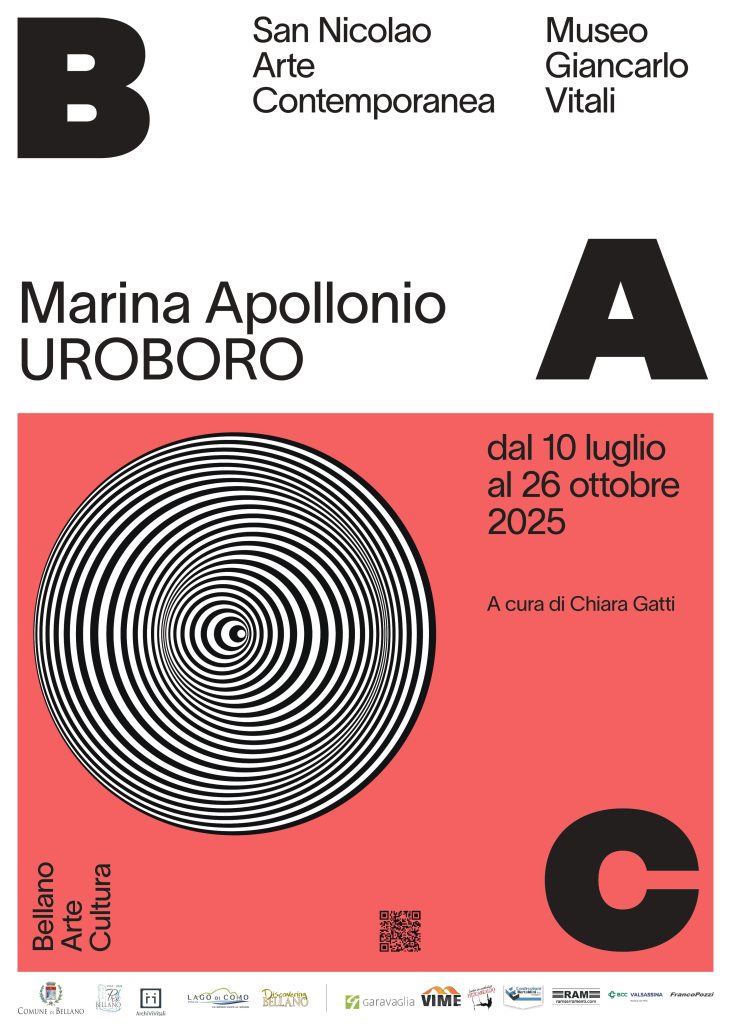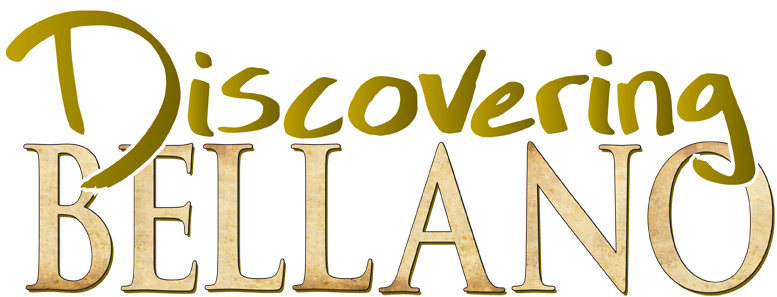Marina Apollonio
UROBORO
Curated by Chiara Gatti
San Nicolao Contemporary Art
Giancarlo Vitali Museum
July 10 to October 26, 2025
Inauguration Wednesday, July 9, 6 p.m. in the presence of the artist.
A few months after the inauguration of the BAC Bellano Arte Cultura project, the Giancarlo Vitali Museum and the ancient space of the church of San Nicolao now devoted to contemporary art are hosting two site-specific installations by the great Italian artist Marina Apollonio, a leading exponent of international optical and kinetic art. Reduced by the important retrospective held at the Peggy Guggenheim Collection in Venice, which ended last March, Apollonio lands in Bellano with an unprecedented project, intended to change the perception of the environments that host her large-scale works, a circular Dynamic of 4 and a half meters in diameter and a perspective Ellipse of almost two meters in height.
The title of the exhibition curated by Chiara Gatti, Uroboro, marries the circularity of the artist’s works and ideally links them to the sacred iconography that echoes in undercurrents to the centuries-old history of San Nicolao, its 14th-century frescoes and the liturgical traces of the original Humiliati convent. A symbol of the cosmos and the eternal since Egyptian tradition, the uroboros was the serpent that, by biting its tail, drew a magic ring, an allegory of the infinite regeneration of life. A new legend with abstract forms now inhabits the church and engages the audience in a sensory journey, in a physical interaction with the image that tricks the senses and, at the same time, activates them.
Always reflecting on the primary form of the circle, Marina Apollonio has explored its every structural variation over the years in order to trigger an internal motion, a harbinger of dynamic relationships between work and environment. At a time when neuroscience, studying the sense organs, thoroughly analyzes the brain’s ability to interpret the signals that reach it, the work of optical art – as it was “conceived” in the 1960s – returns to extraordinary relevance for its inclination to test the nervous system, inviting it to orient itself between truth and perception.
Following the exhibition reserved for the photographs of Giovanni Hänninen, which documented the different stages of the restoration site in San Nicolao, the BAC opens, with Apollonio’s uroboro, the program of exhibitions designed to investigate the languages of the contemporary, placed in relation to the identity of place, landscape and its memory.
Biography
Marina Apollonio was born in Trieste on November 12, 1940, the daughter of contemporary art critic and lecturer Umbro Apollonio. She began her creative research stimulated by the family artistic environment as early as the early 1960s. She focused on geometry and the psychology of perception investigating visual aspects not usual in the art world. She worked in Paris in the Édouard Albert architectural studio. Later in Italy she made his first aluminum reliefs, used fluorescent colors, and devoted himself to ink drawings on paper and early circular dynamics. In tune with the research of programmed art and optical-art, he shares and promotes the idea of depersonalized art in contrast to the informal currents then in vogue. She met Getulio Alviani, who encouraged her to exhibit her work and, in 1964, she won first prize at the biennial “Il Chiodo d’oro” in Palermo. In the same period she comes into contact with Group N, Group T, Dadamaino and the GRAV in Paris. She gains international visibility and esteem by participating in 1965 in the group show Nova Tendencija 3 held at the Suvremene Umjetnosti gallery in Zagreb. At the Aktuel Gallery in Bern she is among the exponents of the exhibition Aktuel ’65, and in October of the same year she participates in Works by Alviani, Apollonio, Scheggi at Galerie Smith in Brussels. In 1968 he met Peggy Guggenheim, who bought one of her works exhibited in the Paolo Barozzi Gallery in Venice. She presented her works at the group show Public Eye at the Kunsthaus in Hamburg. Also in 1968 she made electromechanical animation discs entitled Circular Dynamics, of which she published an edition of multiples for the Duchamp Center. In 1969 she exhibited in the group show Nova Tendecija 4 at the Zagreb Museum. In the second half of the 1970s she made a miniature work for Herbert Distel’s Museum of Drawers, for a collection of 500 works by important artists, including Picasso. In 1981 she turned to weaving, presenting her work in many galleries. More recently, in 2005 she exhibited at the exhibition L’Oeil Moteur at the Museum of Modern and Contemporary Art in Strasbourg. For the Op Art exhibition at the Schrin Kunstahalle in Frankfurt she is finally able to realize a project presented at the Neue Galerie in Graz in the 1960s: a rotating disk ten meters in diameter, titled Space at Kinetic Activation 67-71/2007. On this occasion he exhibited together with historical exponents of optical-art including: Vasarely, Riley, Morellet, Le Parc, Gianni Colombo. In 2013 she participated in the Dynamo exhibition at the Grand Palais in Paris. In 2022 she is present at the 59th edition of the Venice Biennale International Art Exhibition in the thematic “capsule” Technologies of Enchantment.
From Oct. 12, 2024 to March 3, Marina Apollonio is featured in the solo exhibition Beyond the Circle, at the Peggy Guggenheim Collection in Venice.










